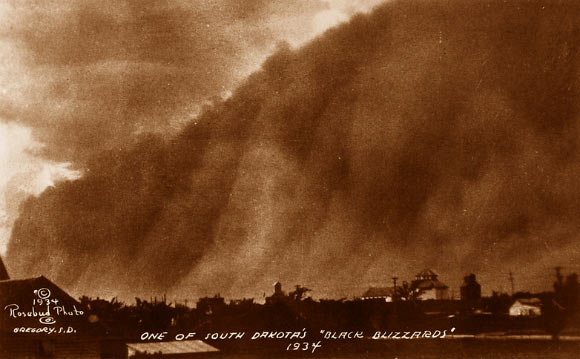Using a reconstruction of North American drought history over the past millennium, a team of researchers from NASA and the Columbia University’s Lamont-Doherty Earth Observatory has found the Dust Bowl drought of 1934 was the worst – about 30 percent more severe than the runner-up drought (in 1580) and extended across 71.6 percent of western North America.

A ‘black blizzard’ dust storm in South Dakota, 1934. Image credit: National Archives FDR Library Public Domain Photographs.
“We noticed that 1934 really stuck out as not only the worst drought but far outside the normal range of what we see in the record,” said Dr Benjamin Cook of NASA’s Goddard Institute for Space Studies, who is the first author of the paper published online in the journal Geophysical Research Letters.
Two sets of conditions led to the severity and extent of the 1934 drought.
First, a high-pressure system in winter sat over the west coast of the United States and turned away wet weather.
Second, the spring of 1934 saw dust storms, caused by poor land management practices.
“These dust storms may have dried things out further and kicked 1934 into a really extreme event,” Dr Cook said.
“In combination then, these two different phenomena managed to bring almost the entire nation into a drought at that time. The fact that it was the worst of the millennium was probably in part because of the human role,” added study co-author Prof Richard Seager of Lamont-Doherty Earth Observatory.
Dr Cook, Prof Seager and their colleagues used the North American Drought Atlas, a database of drought reconstructions dating back nearly 2,000 years that are based on tree-ring studies. They also analyzed records of air- and sea-surface temperatures and precipitation.
According to the team, a combination of changes in sea surface temperatures and a lack of rainfall in the Northwest, Southwest, and across the Southern Plains kicked off dry conditions in the fall of 1933 that by the spring of 1934 would spread to the Central Plains and Midwest.
Major dust storms – the scale of which had not been seen in North America since the Middle Ages – projected dust from the Central Plains as far east as the Atlantic Ocean.
Some of the hardest hit areas – Midwestern states like Nebraska and Kansas – were downwind from where the dust storms originated. In these areas, dust particles accumulated in the atmosphere, reflecting incoming energy from the sun back into space.
These dust-driven energy changes can disturb normal air circulation patterns, and block cloud formation and precipitation, leading to dry conditions.
The findings could help scientists better understand what causes these events and better predict them in the future.
_____
Benjamin I Cook et al. The Worst North American Drought Year of the Last Millennium: 1934. Geophysical Research Letters, published online September 23, 2014; doi: 10.1002/2014GL061661







